Reclamation : Suzanne Stewart-Steinberg
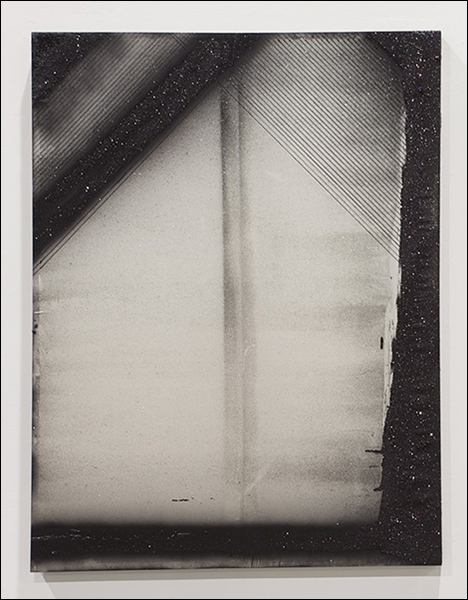
In its most common usage today and the one upon which I focus here, reclamation refers to the conversion of wasteland – especially of land previously under water – into land fit for use, cultivation, or construction. I also, however, extend this meaning to broader political and conceptual uses: the reclamation not only of lands but also of a concept. My thinking about reclamation derives from a study of Italian fascist uses of the term: bonifica is the Italian term used for “reclamation,” signifying etymologically the act of “making good.” Reclamation as bonifica is helping me critically to think about aspects of fascism that remain inadequately theorized. In particular, “reclamation” provides a conceptual apparatus for naming strategies geared to the “fascistization” of Italian culture and society, strategies that do not rely directly or only on top-down actions by the State, but interact with the latter “from the ground up,” as it were, in a dialectical manner.1 In this, I am following the lead of other scholars of Italian fascism, especially that of Ruth Ben-Ghiat. In her groundbreaking work on fascist modernism, she has argued that the idea of “total reclamation [bonifica integrale]” stood at the basis of the regime’s socio-political, economic and cultural politics.2 On the heels of Italian historian Renzo De Felice’s important but very problematic interventions in the 1970s,3 Italian fascism is now studied not just as something imposed from above, but as a political phenomenon that produced a culture of its own. What Roger Griffin in 2001 described as a “velvet revolution” in the historiography of Italian fascism,4 has produced a growing scholarship in Italy and abroad alike, focused on fascism’s goals to produce a radical and sweeping transformation or “reclamation” of Italian society. The depth of such reclamation remains an object much contested, ranging from more critical approaches on the Left to claims by the Right that fascism’s bonifica was nothing short of a revolution in Italy’s class relations and cultural discourses.5 For present purposes, I would like to think through reclamation as a concept, and also to posit the ways in which reclamation raises the problem of conceptuality more generally.6 I propose here a number of “theses,” gleaned from a broad range of disciplines, such as literary and film theory, architectural history, urban and landscape studies, critical geography, political theory. Theoretically speaking, I am interested in the grounds of this concept, wondering about its superstructural effects, wondering indeed how a “hermeneutics of suspicion” holds up in light of the idea of reclamation. Amir Mufti juxtaposes a hermeneutic of suspicion and a hermeneutics of reclamation, preferring the former to the latter.7 But, I will suggest, the concept of reclamation may have something to offer even to those committed to a hermeneutics of suspicion.
Reclamation is a “technique-concept,” insofar as it condenses within itself ekphrastic strategies (reclamation is remarkably garrulous in its continuous need to tell us what it is doing) and transformative drives, showing and telling, an eternal present and a destiny.8 As a technique, reclamation does the work of yoking terms in such a way as to produce a technology of authenticity, just as it also produces an alibi for an authentic technology: its mode of operation is that of the rhetoric of the chiasmus, something quite close to Frederic Jameson’s recent intervention on the “antinomies of realism.” Let us propose that reclamation mobilizes figure and ground, two terms that have been put to use in Gestalt psychology, as well as by media theorists, such as Marshall McLuhan. McLuhan’s famous dictum “The medium is the message,” postulates that the figure (the medium) operates through its context (the ground). The message, which the medium conveys, can only be understood if the medium and the environment in which the medium is used — and which, simultaneously, it effectively creates — are analyzed together. At the same time, the idea of figure also refers to the content of a particular medium, while ground refers to the medium itself.
Reclamation invokes nature – and this in particular through its grounding in the land – as a central element of its operation: nature is reclaimed for possession, use and authenticity. Nevertheless, the term produces a caesura in the concept of “nature,” to the degree that as reclamation, nature itself must be naturalized. As part of this logic, there exists a realm of “nature” that is more than itself, indeed an unnatural, supplementary nature, one that requires active intervention in order to bend it in the right direction. In this sense, reclamation entails both anthropological and ecological interventions into nature. It is a physically ‘redeemed’ Italy that emerges from the submersion by the swamps, that acquires her other constructive dimensions of fecundity…. [The idea of] Italy as the Edenic garden of the world is a mad idea: God demanded from us that we conquer her inch by inch through ardent labor.9 If the reclamation of marshes became synonymous with fascist national regeneration, this was made possible by a process of formulating the idea of a “fascist nature,” grafted upon, but also supplementing a more primordial and destructive one.10 In such a vision, fascist nature was clean, healthy, and virile, while its primordial version was undifferentiated, malaria-infested, hence contagious and subject to forces of permeability and invasion, and therefore of course also feminine.
Reclamation articulates a theory of landscape. In its broadest definition, a landscape is a portion of land that the eye can comprehend at a glance. Applications of such a usage have wavered between the land itself and the picture of that land, and between a natural scenery and a politico-administrative unit, whereby these two uncertainties have remained intimately connected throughout its conceptualization: the land is both the thing itself and its representation, the grounds from which power emerges and the object upon which power comes into being in some other place/space. As a compound word, landscape yokes the land to a scape. In its most general meaning, land signifies a defined, bounded space, while scape is etymologically related to shape and sheaf,11 rendering thus the landscape into a collection or system of lands. Fascism is therefore, and from its first beginnings, deeply implicated in the gathering together of land(s). Comprehended at a glance, landscape is – in John B. Jackson’s words – “a space deliberately created to speed up or slow down the process of nature.”12 Jackson distinguishes between political and inhabited landscapes, the first artificial, the second the result of a “natural evolution.” While the first comes about as the result of actions from above, the second develops from below: it is a vernacular landscape. Jackson views vernacular landscapes as on the defensive, encroached upon by the imposition of political strategies of surveillance, mapping and visualization. Jane Jacobs, whose theories of the ecological impact of the city on the countryside have been profoundly influential, echoes this position. For her, cities can only be saved if we renounce thinking about them as works of art, and instead think of them as natural creatures.13
I propose that reclamation considerably complicates such binarisms. Landscape is both imposed from above and developed from the ground up: reclamation builds the traditional, the authentic, the vernacular. Turning to Mussolini’s “integral reclamation,” and in particular to the regime’s architectural politics: fascism’s famous “Romanism,” that is, its dedication to the return to an imperial past, was supplemented by ecological policies literally written in the ground as also by the recuperation but also the construction of an Italian vernacular past. Italian architectural modernism, was predicated on both, the idea of the tabula rasa or the ex novo and on notions of space thoroughly soaked with meaning. If vernacular architecture, as the “architecture without architects,” is a form of building and inhabiting a space that comes into being from “the ground up,” then in fascist Italy, this was built on the idea of the farmhouse: in Tuscany, Puglia or the “native” villages of the Italian colonies. Paradoxically, it was also built on the idea of a vernacularism without “local” knowledge; that is, on notions of the modular unit or what Benedict Anderson refers to as “seriality” as a necessary component in the project of building a nation.14 Giuseppe Pagano, fascism’s most important exponent of vernacularism, called for an “immense encyclopedia of abstract forms and creative expressions with obvious connections to the land, climate, economy, and technology.” If signs then become the ground upon which to reclaim space and time, several consequences follow. First, the reclaimed landscape is inevitably figurative. In what Noa Steimatsky describes as the “surge of the everyday,” where the marginal, the quotidian, the local come to speak in a universal language, such language has a broad range of genres at its disposal. Steimatsky’s study of Italian neorealist locations detects a landscape that speaks in the lyrical mode.16 Akin to Erich Auerbach’s “mingling of high and low” as fundamental to the act of literary mimesis, Mikhail Bakhtin’s “dialogical imagination,” or Fred Jameson’s “antinomies of realism,” the logic of reclamation relies on strategies of realism as its central mode of expression. In the Italian case, late 19th-century verismo and later neorealism gave rise to a specifically theatrical, choral spin on the language of the land. Second, the reclaimed landscape is always already a map. In this, reclamation effects two fantasy moves simultaneously. On the one hand, its mapping drive “miniaturizes” and “simplifies” – the terms are James Scott’s – in such a way as to make possible local experimentation in order then to generalize. Simplification speaks to rendering the land into observable, easily comprehensible modular and serial units. This takes place from above and from afar, from airplanes, and therefore new technologies of vision are relied upon to generate this vision. From on high, miniaturization allows also for other possibilities: the turning of the land into a theme park. Not only have projects of reclamation been memorialized in theme parks and museums around the world, these projects themselves often bear uncanny resemblances to Potemkin Villages. Indeed, as we will see shortly, reclamation projects and their thematic representation are from the very beginning difficult to pry apart.18
Reclamation is a theory and practice of ruination and ruins. Given the centrality of redeemed landscapes in the work of reclamation, archaeological knowledge provides both temporal breadth and spatial depth to the grounding of reclamation. On the one hand, reclamation does the work of memory, of re-memoration, and as such it is reconstructive and builds in the direction of integration and cohesion, while, in the words of Noa Steimatsky, ruins also “resist a solid, definitive articulation [and] emerge as an arena wherein a monumental thrust is traversed by a force of contingency.”19 Two such modes of operation are central: first, there are those archaeological practices that restore the past as a project of authenticity. Second, yet, ruins pose a problem for the inhabited landscape, that of dwelling: the ruin cannot be a home, even while, in its very monumentality, it authenticates a space and a history. Ruins, Noa Steimatsky writes, “offer material evidence, proclaim the imperative of shelter, of housing.” On the other hand, fascist archaeology tended to isolate monuments, to detach them from their earlier historical contexts, this in the service of a distinction between the “ancient” and the merely “old.” “The millennial monuments of our history must impose in their necessary solitude,” Mussolini proclaimed.20 The isolation of monuments, together with the regime’s dedication to grand exhibitions, turned the fascist land-and cityscapes into a terrain perpetually on display, into a permanent spectacle.
Reclamation projects rely on a form of the aestheticization of politics, one grounded in utopian desires of and for “administration.” What reclamation proposes is a direct connection between utopianism, administration and aestheticization. William Beinart, who studied land reform in Malawi, speaking to “the imagination of what might be possible,” writes:
As Walter Benjamin well knew, the aestheticization of politics was closely connected to the crisis of representation, this to the extent that he understood that this also signified a crisis of the liberal order. Reclamation addresses just such a crisis in the logic of representation (in all its significations). The concept provides a response in two, contradictory but nevertheless coexisting propositions. The first may be described as a radical refusal of all representation in favor of a “logic of presentation,” by which I intend a mechanism in the form of theatricality in and by which what is enacted is a desire for a sublimation or overcoming of representation in all its valences: aesthetic, political and epistemological. At stake here is a presentation, even an acting-out of what Lacan calls the Real – and precisely not reality, which is why we are dealing here with utopian, presentist desires. The affective effectiveness of fascism’s projects of reclamation resides at least partially in this presented but unrepresentable pleasure. Reclamation produces therefore a sort of short-circuit between the event and its registration. A second logic is also in play, one of “hyper-representation.” For, what is particularly arresting is that reclamation produces sites that are “empty.” (I will return to this.) Timothy Mitchell, in Colonizing Egypt, argues that such sites of (re)presentation are at the very core of colonialism. Colonialism refers not only to the domination of and over a territory by an exogenous entity, but also to a new way of conceptualizing time and space, and a new way of manufacturing the experience of the real. Colonialism constructs the world as an exhibition, as a representation. For this reason, it produces a world divided into two: not only between the West and its Other, but also between representations and reality, things and plans:
In world exhibitions, museums, zoos, the architecture of cities, “things” increasingly appear to be built, organized or consumed as signs of something else, while yet these signs evoke some more original and authentic idea or experience. And yet, Mitchell insists, there is no exit from this structure, as the authentic is lived in and as a perpetual deferral. Reclamation, as a concept, names and intervenes in this problem.
Reclamation produces ruralization as the grounds for mediatic social life. It is a mediatic ruralism. It does this not as an ideological call “back to the land or nature.” The nature of reclamation, as previously noted, is already one of supplementarity and displacement. Reclamation depends on an entirely modern project of planning and social engineering, on the distinction between things and plans. Ruralization falls within the logic of reclamation under the purview of a making, under an “urbanistics.” Fascist urbanistics addressed itself as much to cities, as to colonial settlements and to “rural urbanism.” Giuseppe Bottai, one of the most important thinkers of Italian fascism, envisioned urbanistics not only as identical to politics per se. “Rural urbanistica,” so he stated, “might appear to be a contradiction, but is not, because it expresses precisely our objective of giving a new meaning to relations between the city and the function of the country.” Therefore, the regime’s reclamation involved the construction of a vast and capillary system of land divisions and settlements in a fight not only against volatile, moving and nomadic lands, but – and right up the food-chain – also against mobile waters, flying mosquitoes, roaming buffalo and erring humans. Beyond a hypothesized natural setting that from now on would be controlled by the work of pumps, tractors, disciplined labor and hygienic living, Mussolini envisioned a sort of engineered geographical/ecological project, one that could only be put into practice by the construction of an elaborate and hierarchical structure of settlement. Projects of reclamation coincide to a remarkable degree with the creation of nationally organized film industries and especially with the development of the documentary genre: this may be argued for the United States, Soviet Russia, as well as for fascist regimes. With Leni Riefenstahl’s famous 1935 Triumph of the Will, for example, the contours of mediatic ruralism become clear. In Italy, reclamation projects and their filmic registration garnered equal amounts of capital investments and time (this also in the sense of simultaneity): the new film industry not only covered the making of new hybrid landscapes, it actively participated in their making. In a work of mutual support, the newly reclaimed lands and modern media inhabited a shared working space. Not coincidentally, Cinecittà – or Film City – and the New Towns were not only created at the same time during the 1930s, but were architecturally remarkably similar and indeed conceived as models for each other.23 Thus, film and reclaimed lands speak the same modernist language.
Reclamation – as mediatic ruralism – is militarized in several ways. For one, as a totalizing project, it comprehends all aspects of life, as for example in fascism’s “battle of the grain,” the “battle against bachelors, the deserters of paternity,” the demographic “battle of births,” and the defense of the Italic race. The latter was supported by the idea that population transfers and therefore crossbreeding between the variously imagined “Italic” stocks would, like the reclamation of lands, produce a vigorous people, strong enough for further colonial ventures. The workers sent to the Pontine region to drain the lands were depicted as soldiers or assault troupes engaged with battling the malaria-carrying mosquitoes, while the new settlers were to be imbued with a “colonial consciousness,” one that combined military values with those pertaining organically to the land. As Diane Ghirardo and Kurt Forster have noted, the reliance on war metaphors ensured that fascist officials reclaimed land and built cities in order to confirm a conquest by arms, both biological and military.24 Second, the concept of reclamation allowed agriculture and war to be conceived of as in an organic, cyclical relationship: they exist together in a sort of “plowing-back” relationship. Agriculture begets war, and war in turn begets agriculture, all this in a “natural” change or cycle of times. Therefore, reclamation generates a sort of relay effect, whereby energies appear continuously displaced from war to agricultural and urban settlement, and back again to war. These militarized features remain visible today in many museums of reclamation (a point to which I will return), which quite astutely enact in a curatorial manner these same cyclical relations.
Reclamation builds communities that are both closed and permeable. Diane Ghirado and Kurt Forster point out that fascist reclamation projects are
What is particularly striking is that this tower is indeed empty, functional instead not to a concrete message but to a mediatic relay-system. Mussolini’s towers are in this sense more like the cell towers encountered throughout the world today (curiously, often disguised as ruralizing “trees”).
Reclamation constructs an “authentic” even if anxious body, through the combined application of two strategies: filmic realism and the elevation of the agricultural or war vehicle to the new mechanized and militarized subject of history. Italy lacked the cathected image of the German Panzer, the American Sherman Tank, or the Israeli Fascist cultural reclamation was thus conveyed or transported by a truck.29 On the one hand, the regime supported traditional Italian culture in literature, the visual arts, theater and opera through the so-called “Thespian trucks” that traveled throughout the peninsula to bring the classics of Italian theater and opera to all corners of the nation. On the other hand, fascism was grounded in the notion of a vernacular language rooted in a thoroughly modernist soil (and in this sense, it found close aesthetic allies in the Soviet Union and the United States). Indeed, it is precisely this modernist soil that provided the basis for fascist consent. The LUCE Institute (created by Mussolini and put in charge of film propaganda, among other functions) made countless documentaries of the reclamation in the Pontine region, and every time Mussolini visited the area, this too was recorded on film. What is striking about these short films is the frequency with which the tractor appears as the main protagonist of the events being told. The means by which the machine is anthropomorphized are quite subtle, however, for the tractor is not seen here directly to replace humans and animals. Instead, such means effect an operation of displacement in such a way as to produce a fluid visual language of “natural machines” or a “machine nature.” Heart and motor, state and party, ox and tractor, in the project of reclamation find themselves in a space of mutual support, as the (militarized) agricultural vehicle to the subject of history is aestheticized, mediatized by way of the conceptual work of reclamation.
Reclamation is a hermeneutic, one opposed to critique and therefore to the hermeneutic of suspicion: it may be the latter’s worst enemy. Built into reclamation’s projects are, as stated in earlier theses, characteristics that make it a mediatic event dedicated to circumventing issues of representation in the name of the immediacy and authenticity of a ground(ing) in a mechanized event. Projects of reclamation are subject to self-reclamation, in the sense that they tend continuously to desire a recuperation of themselves: this forms part of their basic logic. Such self-reclamation, in turn, provides The reclamation of reclamation constitutes the basis of “post-fascism,” a politico-ideological constellation that distinguishes itself from “neo-fascism” (a position recognized as too intransigent), and as a distinction important enough to recognize because re-reclamation itself insists, paradoxically, on the obliteration of all distinctions. Re-reclamation depends entirely on the memory industry. It builds museums to record its past reclamations31; and it produces a populist historiography buttressed by media sensationalism. Both support the message that politics is the work of corrupt politicians in the Capital, against which the “man on the land” is impotent and from which a safe distance must therefore be sought.32 To conclude. Reclamation (as also its continual re-iteration in the form of re-reclamation) positions the tractor/truck/tank or any other war or agricultural machine as a vehicle conceived as medium. It does so by proposing a form of sociality that is both closed and permeable. It can do this to the extent that it is both military and agricultural. If the concept can function in and as a key to both of these domains, it is because it is pitched on the precipice of a mediatic ruralism. It responds to what is perceived as a crisis of representation in the age of empire and colonialism. Since a crisis is at stake, it provides a theory of ruination as a way to confront the past. The past is grounded in aesthetic practices, and due to the need for grounding, it makes landscapes. Since landscapes are its grounding, reclamation as a concept challenges notions of nature as grounds for thinking; it drains grounds. Reclamation is the conceptual grasp of the mediatic image in the process of being drained of its grounds. Suzanne Stewart-Steinberg is Assistant Professor of Italian studies and Comparative Literature at Brown University. Published on November 16, 2016 1. Beyond the case of Italian fascism (the focus here), the concept of reclamation has found other terrains. It was central to German National-Socialist agricultural policies, as well as to most incarnations of settler colonialism. Equally, however, Communist theory and practice in the shape of Soviet and Maoist agricultural policies, as did also the American New Deal, put to use the idea of reclamation as a broad strategy of controlling nature and re-writing the category of the human. For instance, the concept of reclamation can provide a new lens through which to think about Lenin’s theory of the “withering away of the state” and his project of creating a new Soviet society that ideally would run like a well-oiled machine. While my own use of the term saw its most important articulations beginning in the inter-war period, some of its features may be detected already during the last decades of the 19th century. They are also central to land settlements (in all senses) after the end of WWII. 2. Ruth Ben-Ghiat, Fascist Modernities: Italy, 1922-1945 (Berkeley: University of California Press, 2004). Crucial for Ben-Ghiat is that fascist reclamation efforts are modernizing, not backward-looking. As such they describe what Jeffrey Herf terms “reactionary modernism” (Reactionary Modernism: Technology, Culture, and Politics in Weimar and the Third Reich [Cambridge: Cambridge University Press, 1986]). The idea of reactionary modernism needs to be understood as a comparative term, that is, as a descriptor for a specific mode by which modernization is achieved in particular historical contexts. Returning to Barrington Moore’s now classic 1966 Social Origins of Dictatorship and Democracy: Lord and Peasant in the Making of the Modern World (New York: Beacon Press, 1993), national paths to modernization have overwhelming been conceived as either coming from “below” (democracy) or from “above” (dictatorship). My own contribution here is to challenge such a distinction by arguing for the existence of modernizing strategies that fit less comfortably into these models. 3. De Felice’s multi-volume biography of Mussolini was the catalyst for the historian’s ultimate turn to a rather benevolent interpretation of the Italian dictatorship. Nevertheless, and this especially after the publication of the volume Mussolini il duce. Gli anni del consenso (1929-1936) (Turin: Einaudi, 1974), De Felice’s large and significant cohort of students (Emilio Gentile perhaps the most prominent among them), as also other scholars in Italy and abroad turned to the “consent problem” with increasing frequency. 4. Roger Griffin, ‘The Reclamation of Fascist Culture,’ European History Quarterly 3, no. 4 (2001): 609-620, 610. 5. Perhaps the historical revisionism to have recently gained most notoriety in Italy is the work of Antonio Pennacchi. A media star and recipient of prestigious literary prizes, Pennacchi has brought fascism’s reclamation projects back to public attention and almost single-handedly allowed for a positive, indeed “radical” interpretation of the regime’s bonifica, giving it legitimacy not only as an object of research, but as a valid politics. His Fascio e Martello. Viaggio per le città del duce (Rome-Bari:Laterza, 2008) and his novels Il fasciocomunista. Vita scriteriata di Accio Benassi (Milan: Mondadori, 2003) and especially Canale Mussolini (Milan: Mondadori, 2010; winner of the Strega Prize) have popularized his ideas. 6. This essay is part of a larger book project dedicated to the role of reclamation in Italian fascist and post-fascist discourses. Here I try to think of reclamation as a concept, that is, as a tool of analysis. While recourses to the Italian situation are inevitable, I have nevertheless tried to think through the term in such a way as to make it available also to other contexts. 7. Aamir Mufti, “The Aura of Authenticity,” Social Text 64 18, no. 3 (2000): 87-103. 8. I borrow the idea of a “technique concept” from Jameson: “It is, at least in part, of the very notion of point of view that we will be speaking here and throughout this theory of realism, speaking of it not only as a technique but also as a concept, indeed as something like a technique-concept… and finally as an ideology,” Fredric Jameson, The Antimonies of Realism. (London: Verso Books, 2013), 51. 9. Renzo Larco, ‘L’Italia più nuova e il suo cidice rurale. Alle basi della bonifica rurale,’ Emporium. Rivista mensile illustrate d’arte e coltura 70, no. 419 (1929). 10. For investigations into “fascist nature” as an ecological project, see especially the work of Marco Armiero: Armiero, Marco, and Wilko Graf von Hardenberg, ‘Green Rhetoric in Blackshirts: Italian Fascism and the Environment,’ Environment and History 19, no. 3 (2013): 283–311; Armiero, ‘Making Italians out of Rocks: Mussolini’s Shadows on Italian Mountains,’ Modern Italy 19, no. 3 (2014): 261-274, as well as his Introduction to the latter’s special issue “Fascism and Nature.” 11. Interestingly, the Italian word for sheaf is “fascio” – the root of the word “fascism.” While Mussolini clearly devised the name for his movement from ancient Roman political concepts, it is impossible to discount its connotations connected to the land. 12. John B. Jackson, Discovering the Vernacular Landscape (New Haven: Yale University Press, 1984), 8. 13. Jane Jacobs, The Death and Life of Great American Cities (New York: Vintage Books, 1961), 372-3. 14. Benedict Anderson, Imagined Communities: Reflections on the Origin and Spread of Nationalism (New York: Verso, 1983). 15. Giuseppe Pagano and Guarniero Daniel, Architettura rurale italiana (Milan: Hoepli, 1936). The anthropologist Mia Fuller has written extensively on these topics. See especially her ‘Building Power: Italy’s Colonial Architecture and Urbanism, 1923–1940,’ Cultural Anthropology 3, no. 4 (1988): 455–87; and ‘Tradition as a means to the end of tradition: Farmer’s houses in Italy’s Fascist-era new towns,’ in Nezar Alsayyad, ed., The End of Tradition? (New York: Routledge, 2004), 171–86. 16. Noa Steimatsky, Italian Locations: Reinhabiting the Past in Postwar Cinema (Minneapolis: University of Minnesota Press, 2008). 17. Federico Caprotti has worked extensively on fascist reclamation in the Pontine marshes and has been much attuned to the project’s mediatic aspects. I signal here especially: ‘Destructive Creation: Fascist Urban Planning, Architecture and New Towns,’ Journal of Historical Geography 33, no. 3 (2007): 651–79; ‘Scipio Africanus: film, internal colonization and empire,’ Cultural Geographies 16, no. 3 (2009): 381–401; and with Maria Kaika, ‘Producing the ideal fascist landscape: nature, materiality and the cinematic representations of land reclamation in the Pontine Marshes,’ Social & Cultural Geography 9, no. 6 (2008): 613–34. 18. Such a mapping drive approaches Borges’s fantasy of the exactitude of science, where the map covers and indeed becomes territory. “In that Empire, the Art of Cartography attained such Perfection that the map of a single Province occupied the entirety of a City, and the map of the Empire, the entirety of a Province. In time, those Unconscionable Maps no longer satisfied, and the Cartographers Guilds struck a Map of the Empire whose size was that of the Empire, and which coincided point for point with it. The following Generations, who were not so fond of the Study of Cartography as their Forebears had been, saw that that vast Map was Useless, and not without some Pitilessness was it, that they delivered it up to the Inclemencies of Sun and Winters. In the Deserts of the West, still today, there are Tattered Ruins of that Map, inhabited by Animals and Beggars; in all the Land there is no other Relic of the Disciplines of Geography. —Suarez Miranda,Viajes de varones prudentes, Libro IV,Cap. XLV, Lerida, 1658” (Jorge Luis Borges, “On Exactitude in Science” in Collected Fictions; trans. Andrew Hurley. New York: Penguin Books, 1998; p. 325). 19. Noa Steimatsky, Italian Locations, 43. 20. It is interesting that, as John Jackson has argued, the early American landscape demonstrated similar tendencies: American landscapes “were designed to isolate and protect the objects or people within them. The device persisted longest… in the sitings of important buildings: the freestanding church, … courthouse, … school or college building.” Discovering the Vernacular Landscape, 15. 21. William Beinart, quoted in Scott, Seeing Like a State, 227. 22. Timothy Mitchell, Colonizing Egypt (Berkeley: University of California Press, 1991), ix (my emphasis). 23. Noa Steimatksy has told the extraordinary story of Cinecittà’s post-War use as a refugee camp, when Film City was – in consequence of the Allies’ shutting down of the Italian film industry – turned into a “real” home for thousands of displaced persons in Europe, who literally lived on stage sets and furnished their homes with stage props, “The Cinecittà Refugee Camp (1944-1950),” October 128 (2009): 23-50. 24. Diane Ghirardo and Kurt Forster, “I modelli delle città di fondazione in epoca fascista,” Insediamenti e territorio, Storia d’Italia, Annali 8, ed. Cesare De Seta (Milan: Einaudi, 1985), 634. This co-authored essay appears in modified form in Ghirardo’s comparative study, Building New Communities: New Deal America and Fascist Italy (Princeton: Princeton University Press, 1989). She has additionally contributed to the connections between fascist urbanism and surveillance in “Città Fascista: Surveillance and Spectacle,” Contemporary History 31, no. 2 (1996): 347–72. 25. Ghirardo and Forster, “I modelli delle città,” 658-9 (my emphasis). 26. Ghirardo and Forster, “I modelli delle città,” 653 (my emphases). 27. Claude Lanzmann’s 1994 film Tsahal may be one of the most important representations of an Israeli cathexis to the tank as subject of national redemption. Undoubtedly, in this film the tank is the homoerotic hero of Israeli nationalism. 28. The question of settlement and mobility has, as I have argued elsewhere, been a fundamental issue of Italian national self-definition, The Pinocchio Effect: On Making Italians 1860-1920 (Chicago: University of Chicago Press, 2007). 29. In American and Soviet archives similar discourses and images are prevalent. 30. Jeffrey Schnapp, Staging Fascism: 18BL and the Theater of Masses for Masses (Stanford: Stanford University Press, 1996). 31. The most spectacular museum dedicated to fascist reclamation projects in Italy is the museum in the Agro Pontino, entitled Piana delle orme [Plain of Footprints]. The museum conveys a confusing, but very effective political message – both fascist losers and allied victors are equally celebrated. The overriding message is a sort of ecumenical notion of the organic relationship between agriculture and war. This has made the museum into a pilgrimage site for all memory trains: the soldiers fighting on the side of the Axis and the Allies, between which are placed the rural inhabitants of the region who function as the ideological glue to hold the narrative together. 32. The phenomenon of post-fascism is another form of what historian Sergio Luzzatto has termed “anti-antifascism,” that is the increasingly prevailing idea that fascists have become the victims of a nationally recognized discourse of anti-fascism (established as a fundamental tenet of Italy’s Constitution in 1948). Luzzatto views anti-antifascism as the mode of continuity between the fascist past and its post-fascist present, La crisi dell’antifascismo (Turin: Einaudi, 2004). |

 Reclamation challenges not only notions of agency: are its administrators the true and empirically verifiable agents (and are we therefore in the discourse of ideology, as James Scott might argue), or does it work, in the age of simulacra, by the force of its own mysteriously compelling powers (as Jean Baudrillard might say)? Does it therefore have a sort of conceptual grasp on us?
Reclamation challenges not only notions of agency: are its administrators the true and empirically verifiable agents (and are we therefore in the discourse of ideology, as James Scott might argue), or does it work, in the age of simulacra, by the force of its own mysteriously compelling powers (as Jean Baudrillard might say)? Does it therefore have a sort of conceptual grasp on us? 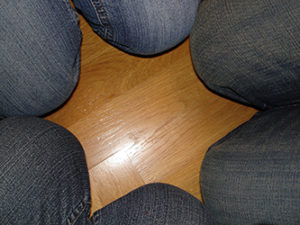 McLuhan’s aphorism can thus be read as an attempt to draw attention away from a preoccupation with figure/message to a consideration of the importance of ground/medium. In light of this, I propose that the concept of reclamation as figure of the ground and as ground of the figure sits uncomfortably in the domain of the concept, indeed challenges conceptuality in significant ways, to the extent that it drains both the ground and the figure of their mutually supportive consistencies. Reclamation is materially close both to the land and all the ideological meanings it may and does evoke. In this sense, reclamation is conceptually unstable. And therefore, as a first definition, I offer the following: “Reclamation is the conceptual grasp of the mediatic image in the process of being drained of its grounds.”
McLuhan’s aphorism can thus be read as an attempt to draw attention away from a preoccupation with figure/message to a consideration of the importance of ground/medium. In light of this, I propose that the concept of reclamation as figure of the ground and as ground of the figure sits uncomfortably in the domain of the concept, indeed challenges conceptuality in significant ways, to the extent that it drains both the ground and the figure of their mutually supportive consistencies. Reclamation is materially close both to the land and all the ideological meanings it may and does evoke. In this sense, reclamation is conceptually unstable. And therefore, as a first definition, I offer the following: “Reclamation is the conceptual grasp of the mediatic image in the process of being drained of its grounds.”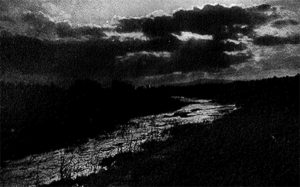 If Italian fascism used a language to describe its project as one that would “reclaim” the authentic values of traditional rural life, it was nevertheless also the case that such a reclamation was founded not only in opposition to “unnatural” and therefore “perverse” life in the cities subject to a frightening range of diseases: industrial unrest, low birth rates, liberal democracy, communism, and other “intellectual talking.” “Sterility” pertained not only to the pathological environment of urbanism. It had equally destructive origins in the death-bringing swamps. In a 1929 article written by Renzo Larco, for instance, we find that, different from other nations, Italy had to make its post-Edenic geography by the sweat of its people’s brow. He writes:
If Italian fascism used a language to describe its project as one that would “reclaim” the authentic values of traditional rural life, it was nevertheless also the case that such a reclamation was founded not only in opposition to “unnatural” and therefore “perverse” life in the cities subject to a frightening range of diseases: industrial unrest, low birth rates, liberal democracy, communism, and other “intellectual talking.” “Sterility” pertained not only to the pathological environment of urbanism. It had equally destructive origins in the death-bringing swamps. In a 1929 article written by Renzo Larco, for instance, we find that, different from other nations, Italy had to make its post-Edenic geography by the sweat of its people’s brow. He writes: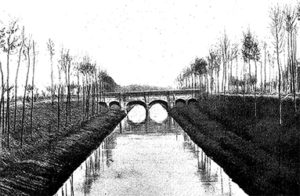 If at work were often simple binary oppositions, it was nevertheless also the case that equally at work were more subtle maneuvers that depended on strategies of displacement and supplementarity, whereby “nature” could signify in many, often opposing directions. The idea of “giving back the land” to those who had “earned” or “deserved” it, was in this sense a return of and to something that had never before existed.
If at work were often simple binary oppositions, it was nevertheless also the case that equally at work were more subtle maneuvers that depended on strategies of displacement and supplementarity, whereby “nature” could signify in many, often opposing directions. The idea of “giving back the land” to those who had “earned” or “deserved” it, was in this sense a return of and to something that had never before existed.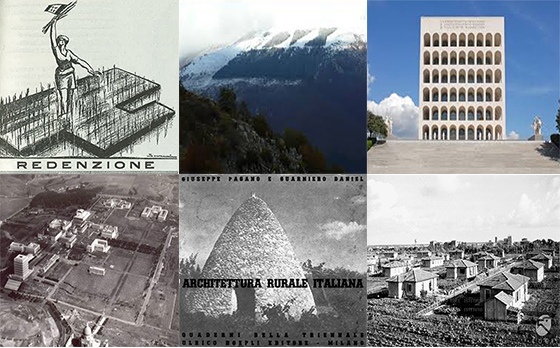
 It was the latter that would constitute both a vast reservoir of references, while yet allowing for the creation of something radically new. His vernacular “signs” required paradoxically both, grounding in the rural earth and a radical unhinging from their contexts.
It was the latter that would constitute both a vast reservoir of references, while yet allowing for the creation of something radically new. His vernacular “signs” required paradoxically both, grounding in the rural earth and a radical unhinging from their contexts.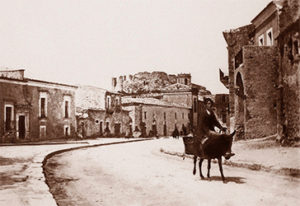 Mussolini built cities as stage-sets, and this to the extent that such building enacted a dramaturgy of nature.
Mussolini built cities as stage-sets, and this to the extent that such building enacted a dramaturgy of nature.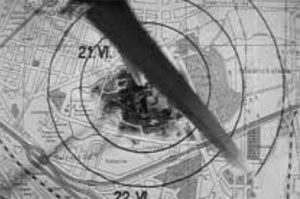 Animated maps first appeared during the first years of reclamation’s great successes, and they provide a fine example of these two forms of mapping: it is perhaps no coincidence that one of the first animated maps appeared in a film centering on surveillance and capture – Fritz Lang’s 1931 M. Animated maps subsequently became tools of landscape and boundaries, and war and movement. Hence Thesis Three’s proposal that reclamation builds a vernacular landscape and is inseparable from its language.
Animated maps first appeared during the first years of reclamation’s great successes, and they provide a fine example of these two forms of mapping: it is perhaps no coincidence that one of the first animated maps appeared in a film centering on surveillance and capture – Fritz Lang’s 1931 M. Animated maps subsequently became tools of landscape and boundaries, and war and movement. Hence Thesis Three’s proposal that reclamation builds a vernacular landscape and is inseparable from its language.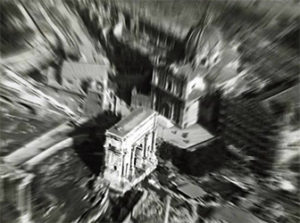 This spectacle produces a reality effect because gestures of isolation work in tandem with gestures of integration and of dwelling. In and as both, reclamation is a theory of ruination to the extent that it proposes the surge of the everyday as sublime ruination.
This spectacle produces a reality effect because gestures of isolation work in tandem with gestures of integration and of dwelling. In and as both, reclamation is a theory of ruination to the extent that it proposes the surge of the everyday as sublime ruination.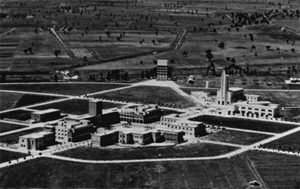 Riefenstahl did not simply “cover” an already pre-existing event (the Nuremberg party rally), but instead the event was from the start a product and function of the filming process itself – this, in order to make participation in the rally more extensive, not limited to actually being “on the ground” in the confined, “lebensraumbedürftig” space of the city of Nuremberg itself. The film thereby extended the very idea of space to a potentially infinite, world-conquering and also utopian domain.
Riefenstahl did not simply “cover” an already pre-existing event (the Nuremberg party rally), but instead the event was from the start a product and function of the filming process itself – this, in order to make participation in the rally more extensive, not limited to actually being “on the ground” in the confined, “lebensraumbedürftig” space of the city of Nuremberg itself. The film thereby extended the very idea of space to a potentially infinite, world-conquering and also utopian domain.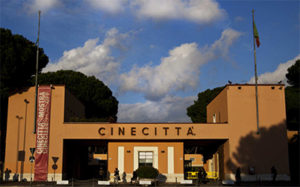
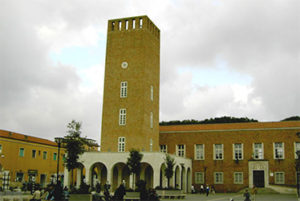 It is precisely the combination, conflation, or condensation of these two factors – closure and this strange power void – that constitutes an important driving principle of fascist reclamation projects, a principle in fact designed to uphold both the “return to regionalism” (hence the emphasis on closure) and yet also centralization (and, therefore, permeability). The perfect symbol – or rather: unifying symptom of this operation of condensation – is provided by the ubiquitous central tower, erected in all of Mussolini’s cities and as the central image of its message. While recalling the tradition of campanilismo (an ideology of the “local” organized around the church tower), and while certainly representing thereby a historical continuity between a medieval then and a fascist now,
It is precisely the combination, conflation, or condensation of these two factors – closure and this strange power void – that constitutes an important driving principle of fascist reclamation projects, a principle in fact designed to uphold both the “return to regionalism” (hence the emphasis on closure) and yet also centralization (and, therefore, permeability). The perfect symbol – or rather: unifying symptom of this operation of condensation – is provided by the ubiquitous central tower, erected in all of Mussolini’s cities and as the central image of its message. While recalling the tradition of campanilismo (an ideology of the “local” organized around the church tower), and while certainly representing thereby a historical continuity between a medieval then and a fascist now,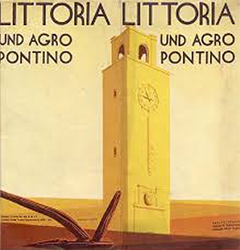 concretely and symbolically, through the figure delegated to represent him. The gesture of the fascist salute… corresponds to the gestural function of the tower: to affirm the unity of the people and its loyalty and obedience to the Duce. The tower not only represents that ritual, but itself becomes ritual, a place of memory for power and order, the omnipresent and indestructible background of the Duce’s virtual presence.
concretely and symbolically, through the figure delegated to represent him. The gesture of the fascist salute… corresponds to the gestural function of the tower: to affirm the unity of the people and its loyalty and obedience to the Duce. The tower not only represents that ritual, but itself becomes ritual, a place of memory for power and order, the omnipresent and indestructible background of the Duce’s virtual presence.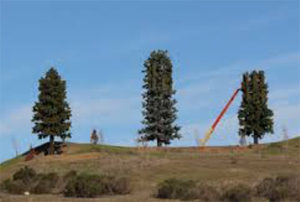 In themselves, these towers signify precisely nothing, are in this sense “voids of power.” Instead they have the function of relaying information at two, but not entirely contradictory levels: on the one hand, “the medium is the message,” and on the other, a panoptical “big brother is watching you.” Both are fluid and flexible.
In themselves, these towers signify precisely nothing, are in this sense “voids of power.” Instead they have the function of relaying information at two, but not entirely contradictory levels: on the one hand, “the medium is the message,” and on the other, a panoptical “big brother is watching you.” Both are fluid and flexible.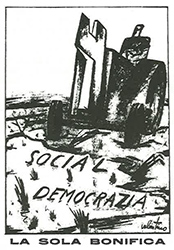 Merkava (“Chariot”)
Merkava (“Chariot”) Its aesthetics relied on a spectatorship as participant to the creation of a national culture, to the extent that such viewers were to be, precisely, both external and yet also present. Fascist neorealism, in this sense, set the literal stage for mass viewing as a form of participation. These “masses,” however, found their form of embodiment in the fascist imaginary not as humans but as machines, made concrete in the agricultural/military vehicle. As analyzed by Jeffrey Schnapp, Alessandro Blasetti’s spectacle entitled 18BL was conceived as a theater project of the masses and for the masses.
Its aesthetics relied on a spectatorship as participant to the creation of a national culture, to the extent that such viewers were to be, precisely, both external and yet also present. Fascist neorealism, in this sense, set the literal stage for mass viewing as a form of participation. These “masses,” however, found their form of embodiment in the fascist imaginary not as humans but as machines, made concrete in the agricultural/military vehicle. As analyzed by Jeffrey Schnapp, Alessandro Blasetti’s spectacle entitled 18BL was conceived as a theater project of the masses and for the masses.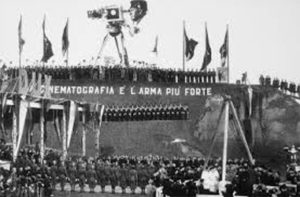 The final act of the drama has the truck commit a kind of sacrificial suicide by letting itself be dumped into the swamps of the Pontine Marshes, all this confirming the close, even organic relationship between agriculture and war.
The final act of the drama has the truck commit a kind of sacrificial suicide by letting itself be dumped into the swamps of the Pontine Marshes, all this confirming the close, even organic relationship between agriculture and war.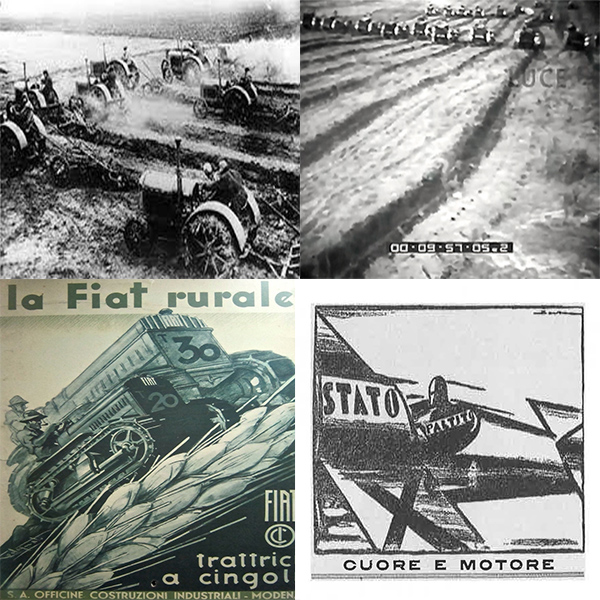 the basis for a language of continuity without thereby necessarily adhering to past political/ideological commitments: reclamation thus makes possible a recuperative language that adheres to the “post-political” and the “post-ideological,” this because it does not need politics in the conventional manner. For this reason also, the reclamation of reclamation constitutes a fundamental building block of historical revisionism: its language can take many forms, as long as it adheres to a position of both, authenticity and shifting meaning.
the basis for a language of continuity without thereby necessarily adhering to past political/ideological commitments: reclamation thus makes possible a recuperative language that adheres to the “post-political” and the “post-ideological,” this because it does not need politics in the conventional manner. For this reason also, the reclamation of reclamation constitutes a fundamental building block of historical revisionism: its language can take many forms, as long as it adheres to a position of both, authenticity and shifting meaning.